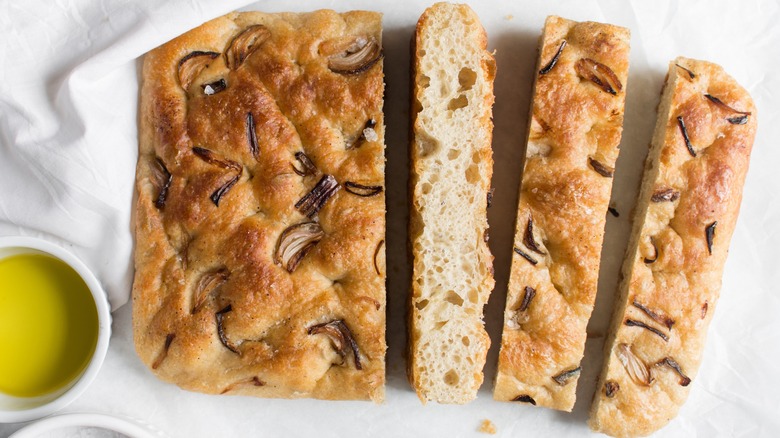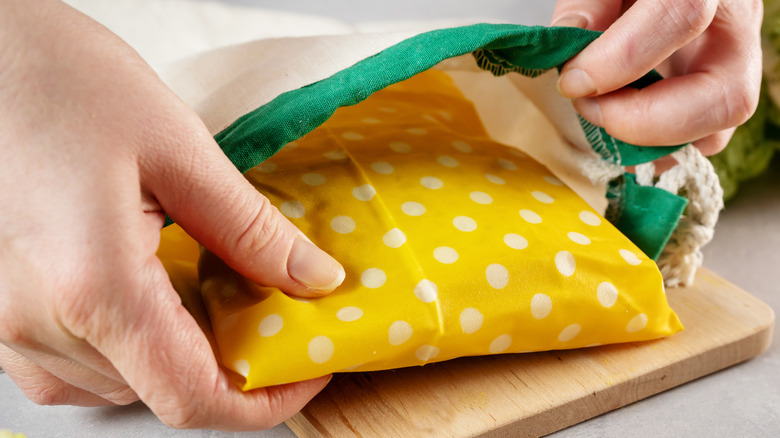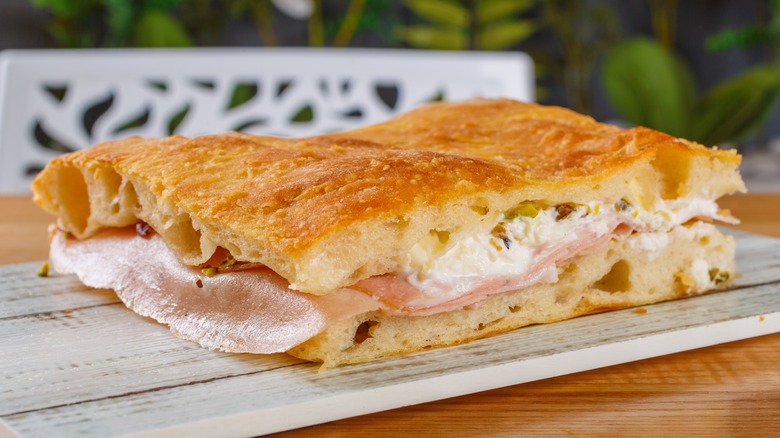Should You Store Focaccia In The Fridge Or At Room Temperature?
When it comes to baked goods, there are few things more alluring and tempting than focaccia. With its heavily salted surface drenched in olive oil and its warm, yeasty aroma, this Italian bread begs to be eaten immediately. While it's easy to get carried away at a bakery, knowing what to do with an entire loaf in your kitchen can be challenging. This fabulous, yet finicky bread goes stale quickly, but don't be tempted to put it in the refrigerator — unless it's heaped with quick-to-spoil ingredients such as meats and cheese, focaccia should always be stored at room temperature.
Bread is notoriously sensitive to temperature while the dough rises, and it's also affected by its environment after baking. Placing bread in a cold space like your fridge accelerates the natural staling process that begins as soon as a fresh loaf comes out of the oven. As time passes and the temperature drops (but not to freezing), the starches break down and change shape through two processes known as "retrogradation" and "recrystallization." The result is a rock-hard loaf of bread. To preserve the fluffy texture and depth of flavor in your focaccia, keep it between 68 to 72 degrees Fahrenheit.
Other tips for storing focaccia
Besides temperature, bread is also affected by exposure to sunlight and air. A kitchen pantry is the perfect place to store focaccia, but if you prefer to have it on the counter for convenience (or so that you don't forget about it while it's fresh), keep it away from any windows, where temperatures are more likely to fluctuate. Even in a cabinet, contact with air can increase moisture loss, causing your bread to dry out more quickly. To limit this, wrap your focaccia in plastic wrap — or, for a more environmentally friendly alternative, use a beeswax wrap — then place it in a bag or airtight container. Stored this way, it should remain soft for two to three days.
If you have more focaccia than you can finish in this relatively short span of time, the freezer is your friend. Securely wrap the loaf as previously described, then place it in your freezer for up to three months. When you're ready for the focaccia, transfer it to the fridge to thaw overnight. (In this case, the fridge is beneficial for maintaining the texture of the bread as it slows the temperature change.) To revive its pillowy interior and crispy crust, pop it into the oven to reheat for a few minutes just before eating.
How to enjoy your focaccia
When you first bring your bread home from the bakery, consider dipping the fresh focaccia in coffee for a signature Italian experience. This breakfast tradition originates from Genoa in the north, but all over Italy, you'll find inspiration for enjoying your focaccia throughout the day. In the nearby town of Recco, for example, they fill their focaccia with stracchino, a creamy type of cheese that creates the perfect gooey cheese pull. At home, you can try a version of this with a similar fresh cheese like ricotta, layering in other ingredients such as prosciutto or tomatoes for a delicious meal that sits midway between a sandwich and a pizza.
Sometimes, despite your best efforts to store and savor your focaccia, you might end up with a slightly stale loaf. If that happens, consider using your leftover focaccia for a French toast upgrade. Alternatively, tear it into pieces and toss it into a food processor to blend into breadcrumbs, which can be used to add texture and flavor to a wide array of Italian dishes, from bowls of meatballs to plates of pasta.



